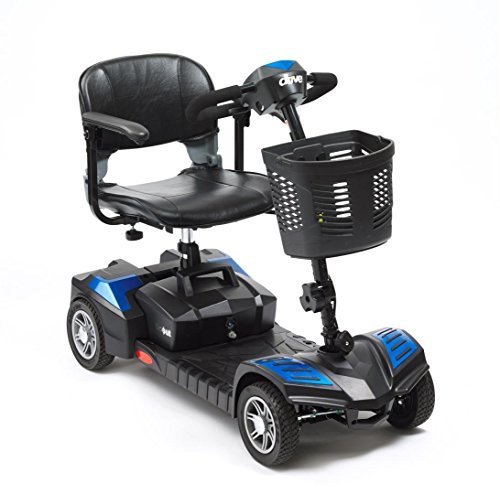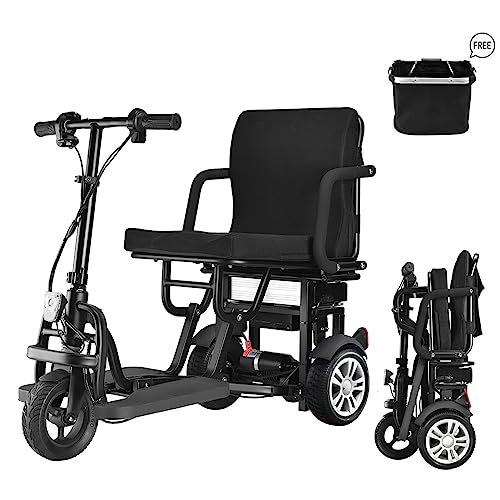 How to Choose Senior Mobility Scooters
How to Choose Senior Mobility ScootersMany older people find mobility scooters to be an effective aid. They are designed to give the user with a comfortable ride on short distances, allowing users to accomplish tasks that would be impossible with a walker, or wheelchair.
Some models can be used indoors, while others are suited to be used on the road or sidewalk. The model you choose will depend on your individual requirements.
Seat Height
Seat height is an important consideration when choosing the best mobility scooter. A high seat height can allow the user to drive comfortably while maintaining a upright posture. A low seat height however, can create discomfort and limit the user's range of motion. Make sure you choose a model with an adjustable seat height to avoid this problem.
When choosing a mobility scooter, it is important to consider the capacity to carry. The weight of the scooter can affect its ease of use and maneuverability, particularly in tight and crowded spaces. In addition the dimensions of the scooter will determine the extent to which it can fit in storage areas and the trunk of the car. It is a good idea to measure the dimensions of potential storage locations and vehicles to ensure that the scooter will fit comfortably.
The type and size of wheels on a mobility scooter can also influence the ground clearance. Larger pneumatic tires and wheels generally provide better traction over bumps, uneven surfaces, and rough terrain. If the person plans on using their scooter primarily outdoors, then it's recommended that they select a four-wheel scooter with high ground clearance to ensure that they can travel over thresholds and curbs smoother.
Many mobility scooters have an additional rear seat which can be hidden under the main seat when not in use. This allows the user to travel with a companion, and can be useful for transporting pets or shopping bags. The seat in the back can be adjusted to height and width and all models come with a secure adjustment mechanism. This is a great option for people with limited space, however it is important to remember that this extra seat will be less comfortable than the primary seat.
Armrests
The armrests on a mobility scooter for seniors must be positioned in such that they don't interfere with the user's ability to use their hands. They should be comfortable and easily adjustable. The best mobility scooters have adjustable armrests that can be moved further or closer away from the seat, allowing the user to position them just right for their body size and needs.
There are many different kinds of armrests that are available each with distinct advantages and disadvantages. One is a single post with a tube vertically inserted into the side frame of the chair. This offers a little more clearance but may be less stable than the dual-post option. Flip down is another alternative. It is attached to the back uprights of the chair and can be turned downwards when not in use. This type of chair provides greater stability, but could be uncomfortable for some people due to the fact that it requires the user to lift their shoulders, which could cause them to lean forward in a slightly unnatural posture.
In addition to the standard features that are available on every power scooter, there are a number of additional accessories that could be bought and added to make your ride more comfortable or functional. Baskets cup holders, baskets, and oxygen tank holders are just a few of the accessories that are available. These items can be easily removed and replaced, allowing you to personalize your mobility scooter as needed.
The purchase of a mobility scooter doesn't have to be an expensive purchase. We have a variety of financing options like Klarna, Shop Pay and other payment plans that give you to spread out your purchase over a period of time. Add the desired items to your cart and select your preferred payment method during checkout.
Handlebars
A scooter is an excellent alternative for those who are limited in their mobility or have a limited upper body movement. A handicap mobility scooters scooter, unlike a walker or wheelchair, is controlled by the steering wheel or tiller situated in the middle of the device. The tiller is similar to the steering wheel on bicycles, but smaller. It also has handles on both sides that control forward and backward motions.
In addition to the tiller, a lot of scooters also have accelerator levers either side of the steering column. They are located close to the tiller. They function in the same way as bike controls. You pull them towards you to move forward and push them away to move in reverse. You'll want to test drive the scooter and make sure you can access the controls using your hands, and have the strength and dexterity required to operate them without pain or discomfort.
Another thing to consider is how far you intend to travel regularly. You'll want to choose a scooter that has enough storage for your usual items, such as a bag of groceries, or personal things like a wallet and a house key. Some scooters have a compartment behind the seat or beneath the deck to store additional items and other models may require special add-on accessories to hold this kind of cargo.
There are numerous benefits of a scooter, it's crucial to think about the pros and cons before making an investment. It is also advisable to talk to your doctor regarding whether a scooter would be suitable for you. They'll be able to give you unbiased advice on the device and assist you determine if it's the best option for your needs.
Tires
The tires on mobility scooters play a major role in the comfort of the ride. They're also an important safety feature. Tires that have been worn down or damaged can begin to deflate. This could be dangerous, both for you and those who ride with you. There are many different types of tires available. There are pneumatic tires, solid tires, and foam-filled tires, ensuring that you can find the right one for you.
Pneumatic or air tires offer an extremely smooth ride and have good shock absorption, which makes them ideal for outdoor use. They're usually equipped with an inner tube that can be patched in the event it gets punctured, but there are also tire without a tube alternatives. Solid or urethane tire are more durable and resistant to flats. They also have a higher pressure. However, they don't have the same level of comfort as an air-filled tire.
Foam-filled tire is a good compromise in between pneumatic and solid tires. They're usually made of a mix of urethane and rubber, and they're maintenance-free. They're also less expensive than pneumatics, however they don't offer the same level of cushioning or shock-absorption.
 Mobility scooters are a great choice for seniors who want to maintain their independence, but require help getting around. They allow them to shop, take excursions, and to visit friends. It's crucial to know what specifications you need and the way your loved one will be using the scooter in order to ensure it's a good fit. Be sure to check out the specifications of your preferred scooter model's turning radius, since this will affect its maneuverability and how easy it is for your loved one to do the errands or meet friends.
Mobility scooters are a great choice for seniors who want to maintain their independence, but require help getting around. They allow them to shop, take excursions, and to visit friends. It's crucial to know what specifications you need and the way your loved one will be using the scooter in order to ensure it's a good fit. Be sure to check out the specifications of your preferred scooter model's turning radius, since this will affect its maneuverability and how easy it is for your loved one to do the errands or meet friends.Battery
The battery of a mobility scooter can have a major impact on the duration of its use. Certain types of batteries are more durable than others. However, maintaining the battery in general and following specific charging guidelines is essential for all kinds of batteries in order to maximize their lifetime.
The majority of mobility scooters for seniors run on lithium-ion or lead acid batteries. Lead-acid batteries produce power through an electrolyte that is made of sulfuric acid. A lithium-ion battery offers a lighter weight, with a longer lasting. Both types of batteries may experience lower performance when exposed to environmental conditions, for example extreme hot and cold temperatures.
Consider the distance you'd like to travel per charge, and whether you will be driving over uneven terrain or steep hills. If you plan on traveling long distances, consider one with a larger capacity battery to ensure your journeys are safe and comfortable.
While a longer battery life isn't required, most older adults prefer the greater feeling of independence that it brings. You can also avail of the many charging stations that are available throughout the country in case you're worried about a full battery run-down.
Most scooters require 4 to 12 hours to reach a full charge, based on the model and battery type. Beware of charging your battery for more than 12 consecutive days and only charge it when the indicator is at its lowest level. Also, if the battery is new you'll need to "break it in" by charging it after every use for the first 15 to 20 times. This will make it work more efficiently.
